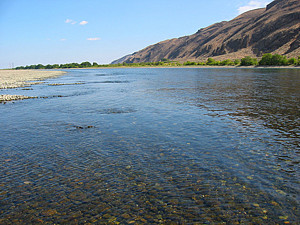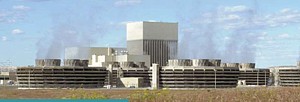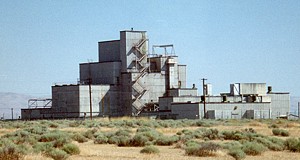The Hanford Reach of the Columbia bends through central Washington for 51 miles along the northern edge of the Hanford Nuclear Reservation roughly between Richland and Priest Rapids Dam. It is the most unaffected, undeveloped part of the Columbia River in the United States, and this is because it has been off-limits to the public ever since World War II, when the government located its secret plutonium production facility at Hanford.
The Columbia River in the Hanford Reach is not exactly free-flowing, as flows are regulated by dams upstream, particularly as the result of the Vernita Bar Agreement, which protects fall Chinook spawning habitat in the reach. But it remains a wild, remote place that probably appears much as it did prior to 1850, when the first Euro-American explorers and settlers began to trickle onto the Columbia Plateau. The largest remaining population of naturally spawning fall Chinook salmon in the Columbia River Basin — more than 80 percent of all fall Chinook in the basin — spawns in the Hanford Reach. Their redds, or egg nests, often are yards across, and in the spring, when the eggs hatch and fish emerge, millions of silvery fish the size of large paper clips dart through the shallows along the shoreline as they prepare to migrate to the estuary and ocean.
The reach is an historic indian fishing site. Local Indians once had numerous camps along the shoreline, places like Tah-Koot and Wy-Yow-Na. These particular camps were on the south shore near present-day Locke Island. We know about them in large part because of the memories of an Indian who called himself Columbia Wildman. He was about 75 years old in 1942 when he told an interviewer about Tah-Koot, where he was born in about 1867.
Tah-Koot was a seasonal village, where Indians caught fall Chinook salmon, but not until after they spawned. This was to ensure salmon for the future, according to Columbia Wildman, who spoke with Edward G. Swindell, Jr., an attorney for the U.S. Department of the Interior, Office of Indian Affairs. Swindell was investigating the location of usual and accustomed Indian fishing sites in Washington and northern Oregon. He was conducting research for the case of Tulee v. Washington, which was in litigation at the time of the interview.
In Tulee, which was decided in 1942, the United States Supreme Court reversed a decision of the Washington Supreme Court and declared that the state could not require Indians to purchase fishing licenses to fish at their usual and accustomed places. A few pages of Swindell’s 323-page report, which covered traditional fishing sites from the Washington coast to the Columbia Plateau, were devoted to the Hanford Reach.
At the height of the annual fishing season, some 500 Indians — many of them families — came to the most popular site, Wy-Yow-Na, about a mile and a half from Tah-Koot. Many Indians camped on Locke Island.
Salmon were plentiful. Some Indians fished at night from two-man canoes. One man would attract the fish with a torch, and the other man would spear them. During the day, the Indians would stretch large nets through the water. The nets, made of hemp, were about 75 feet long and five feet deep.
Each family would catch an average of 300 fish, according to Columbia Wildman. Some were eaten fresh, but most were dried for future use or for trading with other Indians for goods such as roots, berries, meat or buffalo robes.
The Indians who fished at Wy-Yow-Na were ancestors of some of the bands that today make up the Yakama Nation. Many Indians from other places, such as the Nez Perce country, visited Wy-Yow-Na to trade for fish. The visitors did not fish, but they did participate in games and ceremonies.
The last time Columbia Wildman fished at Wy-Yow-Na was about 1904, although he returned every year to partake in feasts and ceremonies. He witnessed a steady decline in the number of salmon over the years. This he attributed to “. . .the activities of the white man in constructing dams and catching very large quantities” of fish, Swindell reported.
Columbia Wildman could not speak English or read a clock, but he had vivid memories of the Hanford Reach of his youth, when Indians fished, feasted, matched skills in vigorous competitions and conducted ceremonies along the shore of the Columbia in the Hanford Reach. Paraphrasing Columbia Wildman, Swindell wrote: “Nowadays there are only a few places of that nature that are used by the Indians due to the fact that almost all of the old places have been destroyed and are no longer of any practical value to the Indians.”
Tah-Koot still is a wild place, undeveloped and remote. Ironically, it likely is contaminated by radioactivity from the decades of plutonium production at Hanford. Fish are still caught in this part of the reach, but there is nothing evident of the fishing village. If by “practical value” Swindell meant economic value, then this place probably does have little value today. But there is a deeper value, a personal, cultural value, a reverence for the ancient places like this one, that lives on in the descendants of Indians who once lived and fished here.
The Hanford Reach is as untouched a place as remains along the Columbia River in the United States, primarily because of its proximity to Hanford, where the government made plutonium for nuclear bombs, including the test bomb detonated in New Mexico and the one that incinerated Nagasaki to end World War. The shoreline, islands and the nuclear reservation are closed to the public except by permission of the Department of Energy. Evidence of ancient habitation is right under foot, particularly on Locke Island where remnant bits of obsidian cutting and scraping tools, and arrow heads, are evident upon close observation.
The irony of the place is as thick as the swirling dust, as cold and clear as the river. Within sight of the places where Indians once gathered to fish, feast, celebrate and trade, the government secretly manufactured explosives that would kill hundreds of thousands of people in a distant land. The same water that nourished salmon cooled the doomsday reactors.
Today, the Hanford Reach fall Chinook are surviving; the population appears stable. Scientists point to the reach as a model for salmon habitat restoration elsewhere on the Columbia. There are periodic political efforts to protect and preserve the reach through legislation, both local and national. There are agreements among fish and wildlife agencies and utilities to protect fall Chinook spawning and rearing, and most of the time these agreements have their intended effect. Sometimes, however, juvenile salmon still are stranded when hydropower operations upstream cause the river level in the reach to recede rapidly. And trouble lurks below the surface: a radioactive plume is inching steadily toward the river from leaking underground waste storage tanks. Its position is known precisely and is monitored regularly; it may be impossible to stop, and its impacts on fish, humans and water quality can only be speculated. Some day, if the nightmare pollution ever is gone, the reach may be more accessible to the public. For now the river slides by in its nearly natural channel, the fish continue to spawn, and access restrictions necessary for public safety remain in effect.





